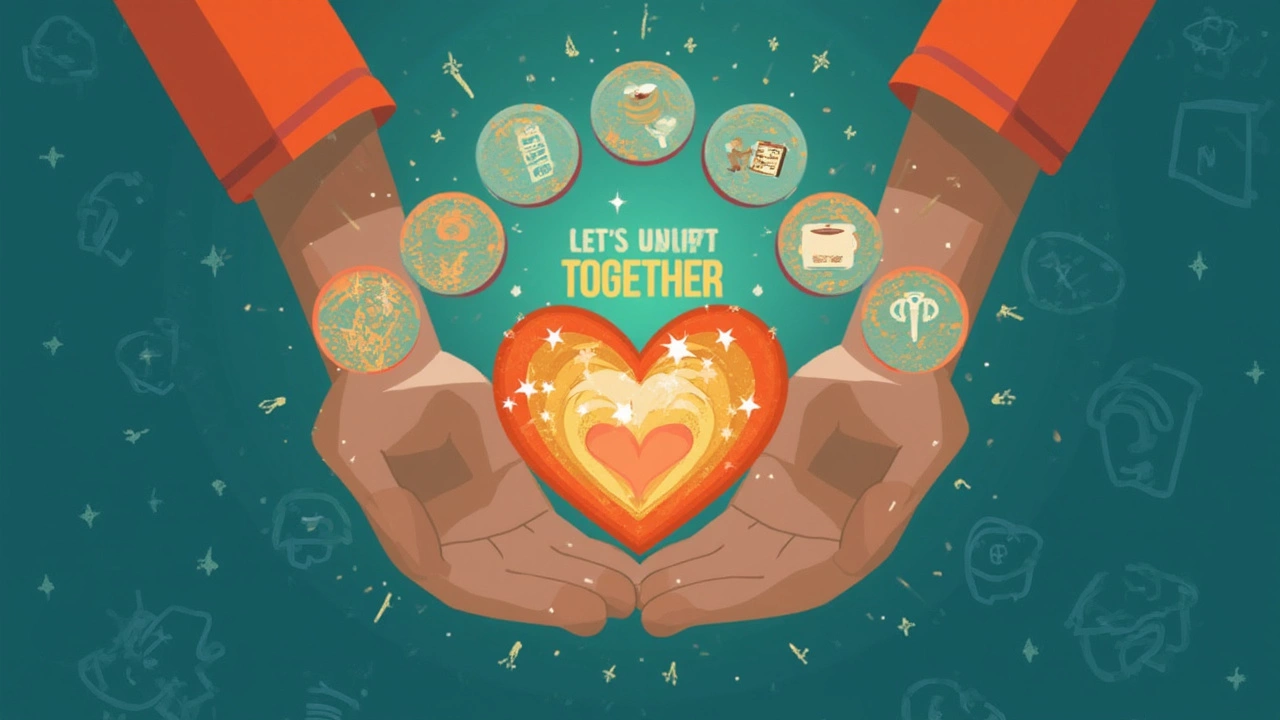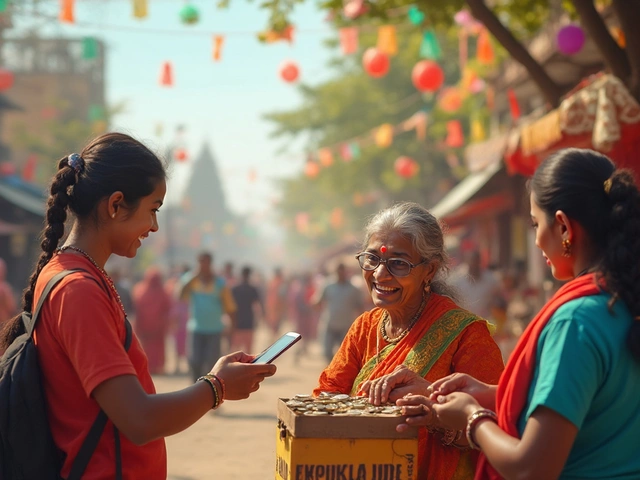The idea of running a charity event sounds good—helping people, getting the community together, maybe even making a real difference. But figuring out where to begin can be overwhelming. You don’t need a huge budget or a fancy degree in event planning to make it work. In fact, most successful small charity events start with a simple plan, a handful of motivated friends, and a clear purpose.
Want to avoid rookie mistakes? Don’t start with a complicated gala. Instead, pick one cause you actually care about. Maybe you want to help local kids get books or raise money for a neighbor’s medical bills. Having a specific goal makes every decision easier—venue, budget, and even what snacks to buy. Keep your event focused, and you’ll waste less time and keep your crew pumped up right to the end.
- Pick Your Cause and Set a Goal
- Sort Out the Practical Stuff
- Find Your People (Volunteers and Partners)
- Get the Word Out Without Blowing the Budget
- Pull Off the Event and Keep It Real
Pick Your Cause and Set a Goal
If you want your small charity event to work, pick a cause people care about—ideally, something you care about too. It's easier to rally support when your reason for fundraising is simple and real. For example, the American Cancer Society says events tied to local issues or loved ones actually raise more than generic charity drives. A clear story sticks in people's heads.
Once you've picked your cause, set a dead-simple goal. Are you raising $500 for animal rescue supplies? Or do you want to collect 200 canned goods for a shelter? Your goal shapes everything, from what you ask people for to how success looks at the end. And seeing that number hit—whether it’s dollars, books, or whatever—feels awesome for everyone who chipped in.
- Start with a cause that's close to the heart. People want to help when they see it means something.
- Talk to folks already working in that area. They might know what’s actually needed instead of what sounds nice on social media.
- Set a tight, specific goal. “Let’s raise $1,000 for winter coats” beats “let’s raise money for charity.” Vagueness makes it harder to motivate volunteers or get people to donate.
- Write down your goal and share it the minute you start spreading the word. It builds trust, and people can see how their help matters.
Back in 2023, a small book drive in Georgia raised twice its goal just because parents could see exactly which school would get the books. When folks know the who, what, and why, they’re way more likely to pitch in—no matter how small the event.
Sort Out the Practical Stuff
This is where your small charity event stops being a dream and actually takes shape. The less you wing it, the less you stress later. Start by figuring out the basics: date, venue, budget, permits (yes, really), and what you’re actually going to do at the event.
Pick a date that doesn’t clash with local holidays, sports games, or big community happenings—otherwise, your crowd shrinks fast. Weekends usually win, but double-check with your crew before locking it in.
When it comes to location, keep it simple. Community centers, local parks, or even someone’s backyard work if you expect a tight group. Public parks sometimes need a permit—call your city’s Parks and Rec office and ask them straight up about costs and rules. For indoor spots, see if local businesses or churches will sponsor the space or give you a discount. A report from the Nonprofit Times found that nearly 60% of small fundraising events rely on donated venues, which saves big cash.
Next, nail down your budget. Here’s what you usually need to cover:
- Venue fees or permits
- Food and drinks
- Tables, chairs, or tents
- Printing (flyers, signs, tickets—if any)
- Insurance (some places require it for events, even small ones)
- Any entertainment, supplies, or prizes
Use a simple spreadsheet or budgeting app—don’t trust your brain to remember all the costs. If you can get stuff donated, even better. Around 71% of event sponsors come from local small businesses, so ask around for food, drinks, or services.
| Expense | Average Cost (USD) |
|---|---|
| Community Center Rental | $50–$200 |
| Permit (City Park) | $25–$75 |
| Tables/Chairs Rental | $1–$4 per chair |
| Food/Drinks per Person | $3–$10 |
| Basic Insurance | $100–$150 |
Lastly, list out exactly what has to get done (and when)—think checklists. Miss permits or payments and you can wreck weeks of effort. If you can, set everything up at least a day early in case something goes sideways. You'll thank yourself, promise.

Find Your People (Volunteers and Partners)
Even for a small charity event, you need more hands than just your own. Volunteers keep things running, and partners can open doors you didn't even know existed. A cool thing: studies show that events with at least six active volunteers raise on average 31% more money than solo-run events. So, don’t try to be a hero—get help!
Start by reaching out to your inner circle. Friends, family, coworkers—they know you and probably want to pitch in for something meaningful. Be clear about what you need, like setting up chairs, making flyers, or running a donation table. People like tasks they can finish, so break jobs down into simple pieces.
When it comes to finding partners, think small and local. Coffee shops, gyms, or even bakeries often love supporting causes that matter to their neighborhood. Offer them a mention on your event signs or social media in exchange for snacks, space, or a donation item. Here’s a fun fact: According to a 2023 report from Nonprofit Source, 60% of local businesses are open to donating if approached with a clear plan and ask. Don’t just send a cold email—walk in, introduce yourself, and explain what you’re doing in about a minute.
“People don’t give to causes. They give to people with causes.” — Simon Sinek, author and motivational speaker
To keep volunteers and partners on board, check in regularly with a quick text or call. After the event, a simple thank you note or homemade cookies go a long way—happy helpers are more likely to help next time, too.
| Source of Help | Easy Ways to Ask | Success Rate |
|---|---|---|
| Friends/Family | Group chat, call, social post | High (~75%) |
| Local Businesses | In-person ask, email, flyers | Medium (~60%) |
| Community Groups | Attend a meeting, share details | Moderate (~50%) |
If you want solid turnout, make helping out easy and maybe even fun. Most people just need a nudge and a good reason. Remember, teamwork makes even a small event run smoother—and it usually leads to bigger results.
Get the Word Out Without Blowing the Budget
Promoting a small charity event can seem impossible if you don’t have a pile of cash for ads. You actually don’t need much money at all if you focus on smart, everyday tactics that people trust. Social media is the top pick, and it’s free. Create a quick event page on Facebook or Instagram, and start inviting friends. Ask your volunteers and anyone interested to share the post. Studies show that when three or more people share a post online about an event, ticket sales go up by about 28% compared to just one person sharing. Don’t be shy—ask folks directly to hit that share button.
Old-school flyers still work, especially in smaller towns. You can design one yourself using free templates on Canva, then print at a local library, school, or even a church for pennies. Pin your flyers at coffee shops, gyms, grocery stores, or anywhere your likely supporters hang out. A personal touch goes further than you think—ask business owners if you can stick up your flyer, or chat with folks while you’re at it.
Email’s not dead, either. Fire off a short message to friends, family, or coworkers and keep it clear—what the event is, when and where, and why it matters. If you have a connection to any local groups, see if you can get a mention in their newsletters. Many community organizations love to highlight local causes, and it won’t cost you a dime.
If you know someone involved with the local press or radio, reach out. Local stations and newspapers often include community news for free. The trick? Give them the basics: what you’re raising money for, who’s involved, and why it matters right now.
- Tap school or sports team newsletters if your cause fits their audience (like a kids’ book drive or community park fundraiser).
- Pitch your story to bloggers who follow local events—real people, not just influencers with big followings.
- Use WhatsApp group chats to send reminders, especially right before the event.
Keep your message consistent and clear. Focus on sharing what your event will actually accomplish. People are more likely to show up (and donate) if they see their support will have a real impact.

Pull Off the Event and Keep It Real
Event day always comes faster than you think. Start with a checklist—sounds boring, but it saves you from forgetting anything crucial. List out the stuff you can’t skip: setting up tables, signs, a welcome desk, clear directions, and a way to collect money or donations. Print your list, and assign jobs. Don't try to do it all yourself. People actually want to help, but if you don't give them something to do, they’ll just stand around looking lost.
Timing can make or break your small charity event. Open the doors early and allow time for set-up hiccups (they will happen). At least one hour before guests arrive, make sure every station is set and tested—donation jars, audio equipment, anything you depend on. Bring backup supplies: tape, extension cords, markers, a few umbrellas if it's outdoors. If you’re serving food, keep things basic. Pre-packaged snacks or pizza are always easier than full-on catering.
Keep energy up by mixing short speeches with fun activities. Nobody wants to sit through an hour of talking. Raffles, games, or even a simple trivia session about your cause goes a long way. Recognize volunteers in front of your crowd—they’ll remember that and might step up again next time. And no one is above bathroom duty: make sure someone checks the facilities every hour.
Track everything during the event—how many donations come in (cash and online), number of guests, and any feedback about what’s working or not. This isn’t just for the big wrap-up. It’ll help you make better calls when you do it again.
| Mistake | How to Avoid |
|---|---|
| Not enough helpers | Extra volunteers on standby; set clear roles |
| Forgot change for donations | Visit bank day before and bag up plenty of small bills |
| No backup for tech gear | Bring portable speakers, extra cords, chargers |
| No schedule posted | Print agenda and post at main entrances |
| Long donation lines | Set up multiple donation spots; use QR codes for digital donations |
At the end, thank everyone, announce how much you raised (even if it’s just an estimate), and snap a bunch of photos. Within 24 hours, post updates and share results with attendees, donors, and on social media. If you show folks their effort made a difference, they're way more likely to pitch in next time. That’s how you grow a small event into something people look forward to every year.





